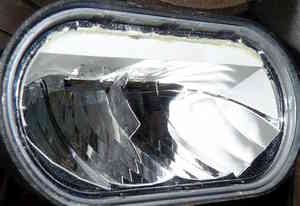
The wall that removes the upper artifacts:

Beamshots for illustration. First row - no wall, regular artifacts. Second column - changed color limits to "zoom in" to the artifacts. Below - with the wall: all upper artifacts removed, only three side ones are left (only 1 of them is clearly seen on the image). (in reality they really remind cat's whiskers :)
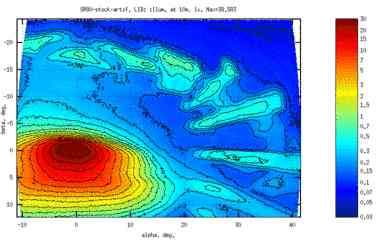
|
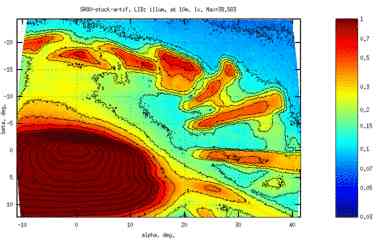
|
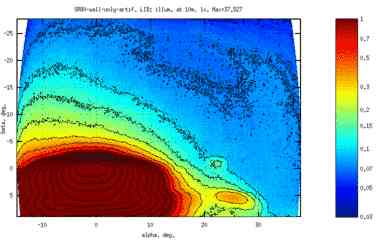
|
There is a small price for removed artifacts: slightly reduced width.
First - no wall, second - with the wall.
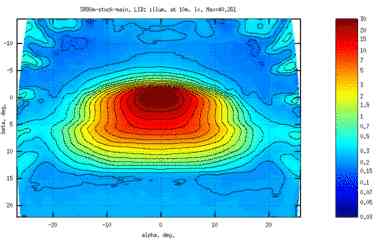
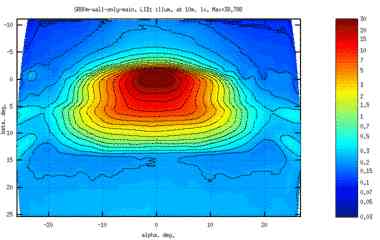
For example, 6th isoline (intensity drops 8 times from the maximum) size at
its bottom:
was 19.55, became 19.05, which is 2.6% drop. (measured in Octave GUI window,
you can't see it well on these images)
I thought the detrimental effect of the wall will be greater, but it is really not noticeable.
(additional stray lighting above cutoff on the second image I think is due to proximity of the wall, it's like the left of the artifacts images).
If you put a visor - a stripe on top of the reflector
(the white one on the first photo), it will
considerably reduce over-all stray lighting above the cutoff.
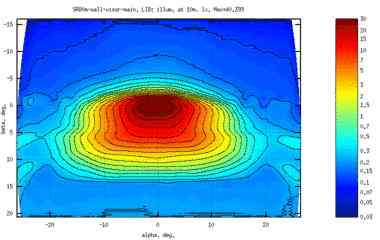
However, the plastic front shield glass brings new stray lighting in. I measured it also reduced light intensity in the main pattern by ~15% (from 40 to 34).
Yes, I also noticed the maximum became higher than it was without the wall. May be previously I waited longer, and both LEDs and regulators heated up, and reduced their performance. I think the position of isolines is more trustworthy (because..), and the above estimate of 2.6% is still good.
It is possible to remove all artifacts, including side ones,
if the wall goes all the way down:
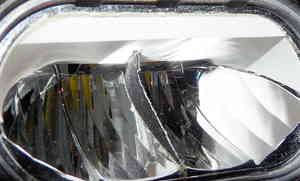
(not showing beamshots) I did it first, but then realized that nobody will
mind the side whiskers.
My wall is black, cut from glued-together pieces of velvet paper. White should work same, it will just be visibly bright.
I glued white paper to the upper reflector surface - I thought it contributed to stray light above cutoff. May be (I didn't make beamshots, so not certain), but it seems to create the two crossed "legs" beneath the main pattern. They help little in the near field, but still do, so do _not_ do it blindly after me. I partially removed that paper later.
I experimented for a while with tiny (SMD) red LEDs, and came to conclusion that pattern shape (not only over-all dimensions, but also how fast intensity decreases from its maximum, etc) is critically tied to LEDs _size_ (not only to their position). Experimenting with emitter shape looks promising to me, but the gains won't worth the efforts. So I decided against fumbling with LEDs replacement, and just soldered the stock Rebels in parallel (need to scratch the LED board).
How to remove the front shield glass - see for example Mission impossible.
When accompanied by additional Near light, even smooth lens-based, the resulting illumination is pretty even, and you don't notice the lit-dark boundary anymore (which is unexpected because a smooth function is added to a discontinuous, so discontinuity will remain). I only wish they'd be same colors (my Near is much warmer).
UPD, Nov 2016: I paralleled LEDs on the PCB with short wires. This is a mistake actually, although it works fine in my case. A little better - take separate wires for each LED from the PCB. Correct way would be to drive each LED separately with its own current source.